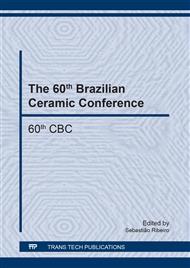p.234
p.240
p.245
p.251
p.257
p.263
p.269
p.274
p.280
Biodiesel from Fatty Acids Found in Brazilian Native Cultures as Soybean and Cotton Using the Nanocatalyst Ni0.5Zn0.5Fe2O4
Abstract:
Biodiesel is a biodegradable fuel derived from renewable biomass, such as soybean and cottonseed oil, which may be obtained by different processes and requires a material to catalyze the obtaining reactions. The irons spinel comes overlapping as excellent materials to catalyze the biodiesel production reactions. Thus, the purpose of this work was the use of Ni0.5Zn0.5Fe2O4 nanoferrite as a catalyst in esterification reactions. The nanoferrite was synthesized by combustion in large scale, 200g/batch, where time and the temperature of the reactions were measured, and characterized by XRD and measuring its surface area. The biodiesel was obtained from methyl and ethyl esterification of acidified soybean oil and cottonseed, at a temperature of 160°C for 1 hour, molar ratio 1:15, 3% of catalyst and analyzed by chromatography. The nanoferrite has shown peaks of greater intensity corresponding to a majority crystal phase of the spinel and a surface area of 64.17m2/g. The conversion results for the soybean oil were 99.08% in methyl route and 98.38% in ethyl route. For cottonseed oil were 88.79% in methyl route and 78.65% in ethyl route.
Info:
Periodical:
Pages:
274-279
Citation:
Online since:
January 2018
Keywords:
Price:
Сopyright:
© 2018 Trans Tech Publications Ltd. All Rights Reserved
Share:
Citation:


